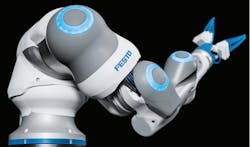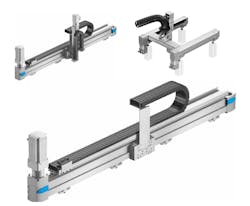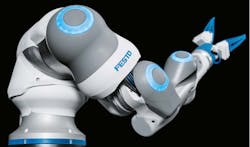Understanding Robots and Their Role in IIoT
The image of the large, six-axis articulated robot welding car and truck bodies became fixed in the popular imagination in the 1970s and 1980s. Since then, articulated robots have spread throughout and beyond heavy industry with many improvements to the robot itself, as well as the development of more end effectors (end of arm tooling) to address the wider need for flexible automation.
Articulated robots are used in sectors as diverse as healthcare, food and beverage, steelmaking, and warehousing—wherever there are repetitive or environmentally or ergonomically challenging tasks that can be accomplished faster, more reliably, and/or more cost-effectively.
Robot basics
Initially, this robot revolution provided major manufacturers like automakers with even greater economies of scale but offered nothing to most small- and medium-sized businesses. More recent developments in cartesian robotics (linear), SCARA and delta robots—along with collaborative robots—have made automation accessible to businesses of almost any size.
Each type of robot comes with benefits and limitations. For new adopters of robotics, it’s important to understand those possibilities and pitfalls.
Robots come with 1-7 axes, each axis providing a degree of freedom. A two-axis cartesian gantry typically plots on the X-Y or Y-Z axes. A three-axis robot has three degrees of freedom and performs its functions through the X-Y-Z axes. These small robots are rigid in form, and cannot tilt or rotate themselves, although they can have attached tooling that can swivel or rotate or adapt to the shape of a small payload. Four- and five-axis robots have additional flexibility to rotate and tilt. A six-axis articulated robot has six degrees of freedom—the flexibility to move objects in any directions or rotate them in any orientation. The latter type is generally chosen when an application requires complex manipulation of objects. The seventh axis allows extended reach in one axis; in other words, it allows displacement of the six-axis articulated robots.
Articulated robots
The popularity of six- and seven-axis articulated robots reflects the great flexibility that six degrees of freedom permit. They are easy to program, come with their own controller and movement sequences, and I/O activation can be programmed via a user-friendly teach pendant. On the hardware side, industrial articulated robots can be relatively small or massive. They can have substantial reach, over three meters with certain models.
The articulated robot also has issues which can restrict its utility or boost its cost profile. A small-sized articulated robot is easy to install; its base only need be bolted to a frame or floor. But it can only lift so much or reach so far.
Where the job requires a larger robot, civil engineering may be required to ensure the structure can handle the weight and torque caused by the load offset. The longer the reach, the greater the payload it can manage, the more space and engineering it requires, the more it costs.
An articulated robot also has singularities, i.e., locations and orientations in the surrounding space it cannot access. These spatial limitations require more complex safety precautions since the robot will often be used in zones where workers are present, even just occasionally. Expensive devices, such as zone scanners or safety mats are often necessary, and more advanced functionalities are then required, such as Safely Limited Speed (SLS), or Safe Speed Monitor (SSM). The fact it requires its own controller to handle the inverse kinematics can also represent a double dip from a hardware perspective since, in certain cases, the robot controller will need to communicate with a higher-level PLC on the production line.
Cartesian robots
A cartesian or linear robot consists of an assembly of linear actuators and sometimes a rotary actuator at the end of arm. The cartesian robot is fully adaptable; strokes and sizes of each axis can be customized to the application. Its reach and payload are independent of each other, not intertwined. The linear axis comes in a number of designs which further adapt it to the function it performs. For example, toothed belt actuators allow high velocities while ball screw actuators permit high precision and high feed force, with pick rates up to 100/min fairly typical.
The adaptability of these handling systems makes them price-optimized for a wide range of straightforward applications where the dexterity of an articulated robot isn’t required. That can involve extremely light to very heavy parts placement, sorting or box-loading, device inspection, and much more. Another major advantage and differentiator of the cartesian robot is its excellent space economy. It allows full access to the footprint it occupies. There is no dead space or singularities. Safety requirements are less stringent and hence less costly since the robot’s reach is limited to its small working zone.
Since the actuators are moving along the workspace coordinate system axis, interpolation of the motors position is not mandatory to determine the robot end-of-arm position in space. In other words, no calculation of inverse kinematics is needed. The system PLC can often be used to control each axis directly, without the addition of a second controller.
The cartesian robot’s main limitation is comparative inflexibility. It will easily accommodate linear movement in three axes, and a fourth, rotative axis. However, one has to add a motion controller to perform more complex synchronized tasks, such as CNC. Cartesian robots are rarely used in washdown environments, as they don’t provide sufficient protection against water ingress.
Finally, cartesian robots, if used without a separate motion controller, may require more programming time than other robot types. Teach pendants are less common, so programming of sequences must be done in the PLC, with each axis addressed and commissioned individually.
SCARA robots
SCARA (Selective Compliance Articulated Robot Arm) robots have been designed and optimized for light applications. They are a streamlined version of articulated robots. They are very adept at functions like inserting components in spaces with tight tolerances while maintaining their rigidity in such movements, which makes them a cost-effective choice in pick-and-place applications as well as small parts handling. Programming and commissioning is relatively easy and fast, using the manufacturer-supplied teach pendant.
A SCARA robot requires a dedicated robot controller and is generally restricted to three axes. It may be the optimal solution where its full capability—three or four degrees of freedom—can be used. If the job only requires two (horizontal and vertical movement, for example), the SCARA robot cannot be reduced to a two-axis system, making it less attractive than a cartesian gantry-style robot from both the cost and performance standpoint. Like the articulated robot, the SCARA robot footprint also extends further than the working zone, resulting in a loss of functional space in and around the unit.
The delta robot is mainly renowned for its speed, with pick rates up to 300/min. Its mounting type puts it above its working zone, limiting the loss of footprint. It is often paired with a vision system to pick pieces randomly placed in more complex sorting and packing applications. Just like the articulated and SCARA robot, it will generally be provided with a teach pendant for easy programming.
The payload capacity of a delta robot is generally much lower than alternative technologies, and its inverse tripod design makes it less robust than the other robot options.
The delta robot has a limited working envelope, as its design does not allow long reaches. Like cartesian and SCARA robots, delta robots are generally limited to four axes and cannot provide the flexibility of an articulated robot.
By allowing a direct collaboration between a worker and robot, collaborative robots (cobots) are adding a dimension to our understanding of how automation can be integrated into industry.
A cobot can be an articulated, cartesian, SCARA, or delta robot, although most would be categorized as articulated. They come with payload capacity of 4-35 kg. The difference between cobots and other robots is their built-in safety features that allow direct interaction with humans without protective shielding, safety curtains, or other safety features.
Since they don’t need fixed external safety barriers, some cobots can be mounted on mobile platforms to go wherever they are needed. It is important to note that a safety evaluation of the application has to be done and, while the cobot itself might be safe, if the tool being used on its end of arm is sharp, an external safety barrier likely would be needed.
The greatest value of cobots is where they can free a skilled employee from the menial aspects of their job to concentrate exclusively on the high value aspects. For example, in complex device assembly requiring a deft human touch, a cobot can perform simple handling or manufacturing tasks in support of the worker, who can then focus exclusively on the part of the job that makes full use of their skills or knowledge.
The proliferation of various robot technologies has enabled businesses of all sizes to access the benefits of Industry 4.0 and digital automation. The best choice of robot usually comes down to the one that is the best fit—not just in terms of an application’s technical requirements, but also from the standpoint of related issues like productivity, plant safety, space utilization, cost, and more.





